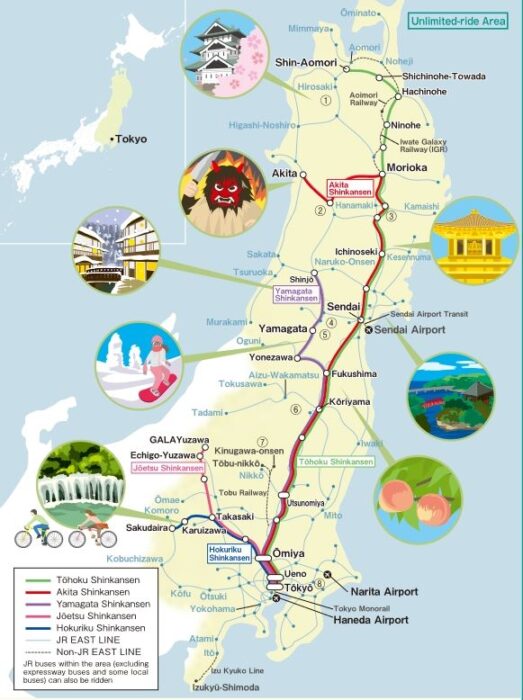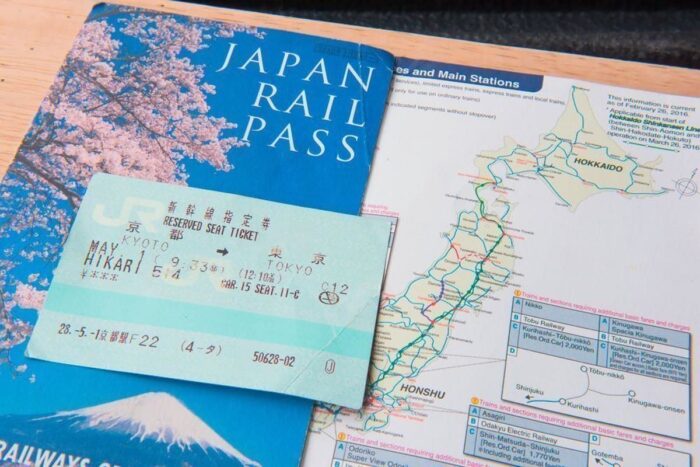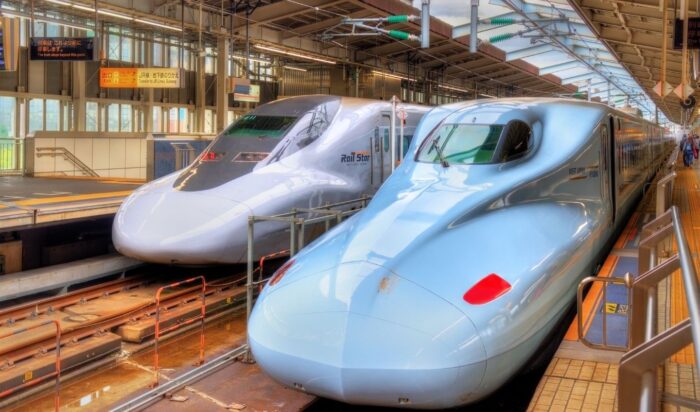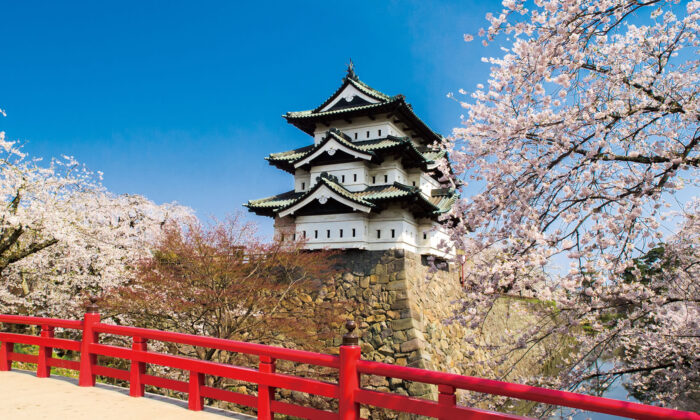If you are looking to use the 5 day JR East Pass for the Tohoku area this guide will help you understand what it is, what’s covered, and how much you can save.
We’ll also run you through 3 sample Itineraries that you can use as a guide to explore Japan’s beautiful Tohoku region.
What Is The JR East Pass Tohoku?

The JR EAST PASS Tohoku area is a rail pass that provides unlimited travel on Japan Rail trains and buses within the Tohoku region of Japan.
This pass can be used by foreign visitors to Japan including foreign residents and is valid for 5 consecutive days allowing travelers to explore the Tohoku region at a discount price.
The Tohoku region is located in the northern part of Japan’s main island, Honshu, and includes cities such as Sendai, Aomori, and Akita. It’s known for its scenic landscapes, historic sites, and delicious local cuisine, making it a popular destination for both domestic and international travelers.
With the JR EAST PASS for the Tohoku area, you can travel on the JR East’s Tohoku Shinkansen (bullet train) between Tokyo and Aomori, as well as on local and rapid trains in the region.
It’s important to note that the pass has some restrictions, such as not being valid on certain express trains, and that it must be purchased online or before arriving in Japan
What Train Services Can I Use with The JR East Pass: Tohoku?
All areas on the map below are covered

This includes the following Services:
- JR East (including Bus Rapid Transit)
- The Tokyo Monorail
- Aoimori Railway Line
- Izu Kyuko Line
- Iwate Galaxy Railway (IGR) Line
- Sendai Airport Transit Line
- You can book Reserved seats in ordinary cars of the following express trains that operate between JR East and Tobu Railway lines: Nikko, Kinugawa, and SPACIA Kinugawa trains.
- You can also use ordinary and rapid trains on the Tobu Railway lines between Shimo-imaichi and Tōbu-nikkō / Kinugawa-onsen.
- JR buses in the area except for highway buses.
How To Buy The JR East Tohoku Pass
The JR East Tohoku Pass can only be purchased online or through authorized sales agents.
If buying online you can purchase through a company such as Klook or via the official JR East website which is admittedly a bit clunky.
Once you have decided to purchase the pass, you will need to select the start date, duration, and number of passes you need. You will also need to provide your personal information and payment details.
After completing the purchase, you will receive a voucher, which you will need to exchange for the actual pass at a designated JR East station upon arrival in Japan. It is recommended to purchase the pass in advance to ensure availability and to avoid long lines.
JR Pass Vs JR East Tohoku Pass: Which Should You Choose?

The JR Pass (7 days) costs 29,110 yen for an adult and offers unlimited train rides throughout Japan while The JR East Pass: Tohoku (5 days) costs 19,350 yen for an adult and covers the Tohoku region exclusively, making it more affordable but shorter and more limited.
The JR Pass is best for extensive travel and can be a better value if also visiting other regions such as Hokkaido, while the JR East Pass is great for those staying in the Tohoku region or on a budget.
Here’s a look at the 2 passes side by side:
JR Pass (7 days):
- Offers unlimited train rides on all JR trains in Japan, making it a great option for extensive travel throughout the country
- Convenient for travelers visiting multiple regions or cities, such as Tokyo, Kyoto, and Hiroshima
- Provides access to all JR trains, including shinkansen and limited express trains
- More expensive than regional passes like the JR East Pass: Tohoku
- Can be a better value if also visiting Hokkaido or starting/finishing travel from Osaka or Kyoto
- Not available to foreign residents (only visitors)
JR East Pass: Tohoku (5 days):
- Can be used by residents of Japan with a foreign passport, unlike the JR Rail Pass which is only for non-residents.
- A great option for those exploring the Tohoku region exclusively
- More affordable than the JR Pass (7 days), making it a great value for those staying in the Tohoku region
- Only covers the designated Tohoku region, not ideal for extensive travel throughout Japan or outside the region
- Shorter validity period of 5 days may not be sufficient for some travelers
How Much Money Can You Save With The Pass?

The amount you can save with the JR East Pass: Tohoku depends on your travel itinerary and the number of train rides you plan to take within the designated Tohoku region. However, in general, the pass is designed to provide cost savings for those who plan to take multiple train rides during their trip.
Here are some examples of how much you can save with the JR East Pass: Tohoku:
Tokyo to Hirosaki
Without the pass: A one-way shinkansen ticket from Tokyo to Shin-Aomori costs around 17,000 yen, and a limited express train from Shin-Aomori to Hirosaki costs around 3,000 yen so for a round-trip ticket you are looking at around 40,000 yen.
With the pass: The 5-day JR East Pass for Tohoku costs 19,350 yen. With the pass, you can take the shinkansen from Tokyo to Shin-Aomori and then take the local train from Shin-Aomori to Hirosaki without any additional fees, saving you over 20,000 yen plus any additional `travel you use the pass for in between.
Tokyo to Akita
Without the pass: A one-way shinkansen ticket from Tokyo to Akita costs around 18,000 yen so a round trip would cost around 36,000 yen.
With the pass: The 5-day JR East Pass: Tohoku costs 19,350 yen. With the pass, you can take the shinkansen from Tokyo to Akita and back which will save you well over 16,000 yen when additional travel is factored in.
Tokyo to Sendai
If you’re traveling from Tokyo to Sendai and back, the JR East Pass: Tohoku 5-day will save you a significant amount of money on transportation costs.
Without the pass, a one-way shinkansen ticket from Tokyo to Sendai costs around 11,000 yen. A Shinkansen train between Tokyo costs around 11,000 yen so a round-trip ticket would cost around 22,000 yen.
However, with the JR East Pass: Tohoku, you can take unlimited train rides within the designated Tohoku region during the 5-day validity period for only 19,350 yen. This means that you can travel from Tokyo to Sendai and back without any additional fees, saving you approximately 2,650 yen.
Hirosaki and Akita City Itinerary
This exact itinerary is shown down the page in full and it’s a good example of how much you can save if you are planning to see a lot of Tohoku over the 5 days.
The estimated total cost for transportation would be over 48,000 yen if purchasing individual train tickets. However, if you use the JR East Pass: Tohoku, you can take unlimited train rides during the 5-day validity period for only 19,350 yen, which saves you a whopping 28,000 yen plus.
Note that these are rough estimates and the exact costs may vary depending on the specific train service or route you take.
So, as you can see, the JR East Pass: Tohoku can offer some great cost savings for those who plan to take multiple train rides within the designated Tohoku region, and can provide great value for travelers looking to explore Northern Japan.
JR East Tohoku Pass Itineraries
Here are three sample travel itineraries for a 5-day JR EAST PASS Tohoku Area.
Hirosaki and Akita City Itinerary

Day 1: Tokyo to Sendai
Take the shinkansen from Tokyo Station to Sendai Station (approximately 1 hour and 30 minutes). Explore the historic city of Sendai and visit the iconic Zuihoden Mausoleum or the Aoba Castle ruins.
Day 2: Matsushima and Yamadera
Take a train to Matsushima-Kaigan Station and visit Matsushima Bay, known for its picturesque scenery of small islands and pine trees. Then, take a train to Yamadera Station and hike to the Yamadera Temple, which offers a breathtaking view of the surrounding mountains.
Day 3: Aomori and Hirosaki
Take a train to Aomori Station and transfer to Hirosaki where you can visit the Hirosaki Castle and Park, and enjoy the beautiful cherry blossoms in the spring and the stunning autumn foliage in the fall.
Day 4: Akita
Take a train to Akita Station and explore the unique Akita culture at the Akita Museum of Art, where you can see the works of local artists and traditional crafts. You can also visit the Akita Senshu Park and see the remains of Kubota Castle.
Day 5: Fukushima
Take a train to Fukushima Station and visit Tsuruga Castle and enjoy the cherry blossoms in the spring or the colorful autumn leaves in the fall. You can also explore the unique Oku-Aizu region, known for its traditional thatched-roof houses and local cuisine.
Snow Monsters and Hot Springs Tour Itinerary

Day 1: Tokyo to Zao Onsen
Take the shinkansen from Tokyo Station to Yamagata Station (approximately 2 hours and 30 minutes), then take a local train to Zao Onsen Station (approximately 40 minutes). Soak in the natural hot springs of Zao Onsen and enjoy the stunning snow monsters during the winter season.
Day 2: Yamagata City Tour
Take a train to Yamagata Station and visit the Yamadera Temple, which offers a breathtaking view of the surrounding mountains. You can also explore the historic city center of Yamagata and visit the Mogami Yoshiaki Historical Museum.
Day 3: Akita
Take a train to Akita Station and visit the Kakunodate Samurai District, known for its well-preserved samurai houses and traditional streetscape. You can also visit the Akita Senshu Park and see the remains of Kubota Castle.
Day 4: Aomori
Take a train to Aomori Station and visit the Oirase Stream, known for its pristine water and picturesque waterfalls. You can also visit the Nebuta Museum Wa Rasse and learn about the history and art of the famous Nebuta Festival.
Day 5: Hirosaki and Return to Tokyo
Take a train to Hirosaki Station and explore the Hirosaki Castle and Park, where you can enjoy the beautiful cherry blossoms in the spring and the stunning autumn foliage in the fall. Then, take the shinkansen back to Tokyo Station (approximately 3 hours and 30 minutes).
Coastal and Rural Tohoku Itinerary

Day 1: Tokyo to Iwaki
Take the shinkansen from Tokyo Station to Iwaki Station (approximately 2 hours and 30 minutes). Explore the coastal town of Iwaki and visit the Aquamarine Fukushima aquarium.
Day 2: Tadami Line and Ouchijuku
Take a train to Aizu-Kawaguchi Station and transfer to the Tadami Line, which offers a scenic route through the rural landscape of Fukushima prefecture. Get off at Yunokami Onsen Station and visit the Ouchijuku, a well-preserved Edo-period post town.
Day 3: Kitakata and Bandai-Azuma Skyline
Take a train to Kitakata Station and explore the Kitakata Ramen village, known for its unique style of ramen noodles. Then, take a bus to the Bandai-Azuma Skyline and enjoy the panoramic views of the Bandai volcanic range.
Day 4: Towada-Hachimantai National Park
Travel to Morioka Station and transfer to a local bus to Towada-Hachimantai National Park, known for its pristine lakes and waterfalls. Visit the Oirase Stream and Choshi Otaki waterfall.
Day 5: Return to Tokyo
Take a train from Morioka Station back to Tokyo Station (approximately 2 hours and 30 minutes).
What Other JR East Pases Are There?

There are 3 main types of JR East Passes available, each with different coverage areas and validity periods. Along with the Tohoku pass there is the Tohoku Nagano, Niigata Pass and the Tokyo wide Pass.
JR East Pass: Nagano, Niigata
The JR East Pass for Nagano and Niigata provides unlimited train rides on JR East trains in the designated Tohoku and Niigata regions for a period of 5 days. This pass is ideal for those who plan to explore both the northern part of Honshu and the Niigata region, which is known for its sake breweries and scenic coastal areas.
JR Tokyo Wide Pass (Kanto Area)
Allows unlimited train rides on JR East trains in the designated Tokyo metropolitan area for a period of 3 days. This pass is ideal for those who plan to explore the city of Tokyo and its surrounding areas.
JR East-South Hokkaido Rail Pass
The JR East-South Hokkaido Rail Pass – provides unlimited train rides on JR East and JR Hokkaido trains for a period of 6 days. This pass is ideal for travelers who plan to visit both the tohoku region and the southern parts of Hokkaido.
Hokkaido Rail Pass
The Hokkaido Rail Pass allows unlimited travel on JR Hokkaido trains, including the limited express and local trains, for a designated period of time. The pass is designed to help travelers explore the northern island of Hokkaido, which is known for its natural beauty, winter sports, and delicious seafood.
The Hokkaido Rail Pass is available for 5, or 7 consecutive days, and provides access to popular destinations such as Sapporo, Asahikawa, Hakodate, and Eastern Hokkaido. The pass is a great value for those planning to travel extensively in Hokkaido.
What Lines Can I Use with The JR East Pass: Tohoku?

You can use all JR lines in the Tohoku region:
With the JR East Pass: Tohoku, you can use the following train lines operated by JR East within the designated Tohoku region:
- Tohoku Shinkansen (Yamabiko, Hayabusa, and Nasuno)
- Joetsu Shinkansen (Tokyo-Niigata)
- Akita Shinkansen (Komachi)
- Yamagata Shinkansen (Tsubasa)
- Ou Main Line (between Fukushima and Aomori)
- Senseki Line (between Sendai and Ishinomaki)
- Joban Line (between Iwaki and Iwanuma)
- Tadami Line (between Aizu-Kawaguchi and Koide)
- Ban-etsu West Line (between Niitsu and Aizuwakamatsu)
- Ban-etsu East Line (between Koriyama and Iwaki)
- Iwate Ginga Line (between Morioka and Hachimantai)
- Hachinohe Line (between Hachinohe and Kuji)
- Ofunato Line (between Ichinoseki and Kamaishi)
- Kamaishi Line (between Hanamaki and Kamaishi)
- Rikuu East Line (between Kogota and Miyako)
- Rikuu West Line (between Miyako and Kuji)
Note that the pass does not cover JR trains operated outside the designated Tohoku region, such as the Tokaido Shinkansen (Tokyo-Kyoto/Osaka) and Hokkaido Shinkansen (Shin-Aomori-Sapporo). If you also plan to visit Hokkaido you will probably be better off with a 7 or 14-day Japan-wide JR Pass that covers all regions including Tohoku and Hokkaido.




